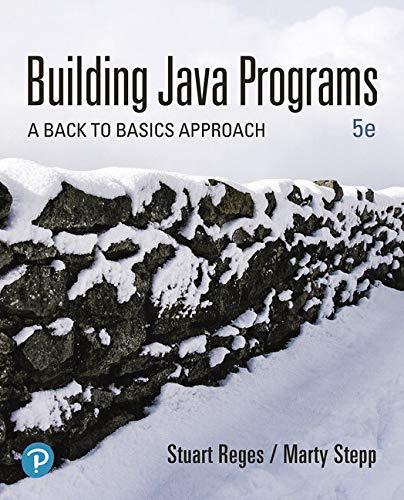
Rearrange stack of integers
Program plan:
- Import necessary packages.
- Create a class “StackSplit”,
- Define the method “splitstack ()” that accepts stack of integers,
- Construct “LinkedList” object.
- Calculate the stack size.
- Execute till stack is empty,
- Transfer all the stack elements from stack to queue.
- Execute loop till the stack size,
- Assign the element removed from the queue to the variable.
- Check whether the element is negative,
- Insert the element into the stack.
-
- Otherwise,
- Insert the element into the queue.
- Otherwise,
- Execute till queue is empty,
- Transfer non-negative integers from queue to stack.
- Print stack of integers after rearranged.
- Define the method “main()”,
- Create object for “Stack”.
- Add integers into the stack.
- Print the stack of integers.
- Call the method “splitStack()” with stack as parameter.
- Define the method “splitstack ()” that accepts stack of integers,
This program demonstrates the method that accepts a stack of integers and rearranges its elements.
Explanation of Solution
Program:
File name: “StackSplit.java”
//Import necessary packages
import java.util.LinkedList;
import java.util.Queue;
import java.util.Stack;
//Create a class
class StackSplit
{
//Define the method
public static void splitStack(Stack<Integer> s)
{
//Construct LinkedList object
Queue<Integer> q1 = new LinkedList<Integer>();
//Calculate the stack size
int old_Length = s.size();
//Execute till stack is empty
while (!s.isEmpty())
{
//Transfer all elements from stack to queue
q1.add(s.pop());
}
//Execute till the stack size
for (int i = 1; i <= old_Length; i++)
{
//Assign the element removed from the queue
int n1 = q1.remove();
//check whether the element is negative
if (n1 < 0)
{
//Insert the element into the stack
s.push(n1);
}
else
{
//Insert the element into the queue
q1.add(n1);
}
}
//Execute till queue is empty
while (!q1.isEmpty())
{
/*Transfer non-negative integers from queue to stack*/
s.push(q1.remove());
}
//Print stack of integers
System.out.println("The elements of a stack of integers after rearranged: "+s);
}
//Define the main() method
public static void main(String[] args)
{
//Create object for Stack
Stack<Integer> s1=new Stack<Integer>();
//Add the integers into the stack
s1.push(3);
s1.push(-5);
s1.push(1);
s1.push(2);
s1.push(-4);
//Print the stack of integers
System.out.println("The elements of a stack of integers: "+s1);
//Call the method
splitStack(s1);
}
}
Output:
The elements of a stack of integers: [3, -5, 1, 2, -4]
The elements of a stack of integers after rearranged: [-4, -5, 2, 1, 3]
Want to see more full solutions like this?
Chapter 14 Solutions
Building Java Programs: A Back To Basics Approach (5th Edition)
- Complete the JavaScript function addPixels () to calculate the sum of pixelAmount and the given element's cssProperty value, and return the new "px" value. Ex: If helloElem's width is 150px, then calling addPixels (hello Elem, "width", 50) should return 150px + 50px = "200px". SHOW EXPECTED HTML JavaScript 1 function addPixels (element, cssProperty, pixelAmount) { 2 3 /* Your solution goes here *1 4 } 5 6 const helloElem = document.querySelector("# helloMessage"); 7 const newVal = addPixels (helloElem, "width", 50); 8 helloElem.style.setProperty("width", newVal); [arrow_forwardSolve in MATLABarrow_forwardHello please look at the attached picture. I need an detailed explanation of the architecturearrow_forward
- Information Security Risk and Vulnerability Assessment 1- Which TCP/IP protocol is used to convert the IP address to the Mac address? Explain 2-What popular switch feature allows you to create communication boundaries between systems connected to the switch3- what types of vulnerability directly related to the programmer of the software?4- Who ensures the entity implements appropriate security controls to protect an asset? Please do not use AI and add refrencearrow_forwardFind the voltage V0 across the 4K resistor using the mesh method or nodal analysis. Note: I have already simulated it and the value it should give is -1.714Varrow_forwardResolver por superposicionarrow_forward
- Describe three (3) Multiplexing techniques common for fiber optic linksarrow_forwardCould you help me to know features of the following concepts: - commercial CA - memory integrity - WMI filterarrow_forwardBriefly describe the issues involved in using ATM technology in Local Area Networksarrow_forward
- For this question you will perform two levels of quicksort on an array containing these numbers: 59 41 61 73 43 57 50 13 96 88 42 77 27 95 32 89 In the first blank, enter the array contents after the top level partition. In the second blank, enter the array contents after one more partition of the left-hand subarray resulting from the first partition. In the third blank, enter the array contents after one more partition of the right-hand subarray resulting from the first partition. Print the numbers with a single space between them. Use the algorithm we covered in class, in which the first element of the subarray is the partition value. Question 1 options: Blank # 1 Blank # 2 Blank # 3arrow_forward1. Transform the E-R diagram into a set of relations. Country_of Agent ID Agent H Holds Is_Reponsible_for Consignment Number $ Value May Contain Consignment Transports Container Destination Ф R Goes Off Container Number Size Vessel Voyage Registry Vessel ID Voyage_ID Tonnagearrow_forwardI want to solve 13.2 using matlab please helparrow_forward
 Database System ConceptsComputer ScienceISBN:9780078022159Author:Abraham Silberschatz Professor, Henry F. Korth, S. SudarshanPublisher:McGraw-Hill Education
Database System ConceptsComputer ScienceISBN:9780078022159Author:Abraham Silberschatz Professor, Henry F. Korth, S. SudarshanPublisher:McGraw-Hill Education Starting Out with Python (4th Edition)Computer ScienceISBN:9780134444321Author:Tony GaddisPublisher:PEARSON
Starting Out with Python (4th Edition)Computer ScienceISBN:9780134444321Author:Tony GaddisPublisher:PEARSON Digital Fundamentals (11th Edition)Computer ScienceISBN:9780132737968Author:Thomas L. FloydPublisher:PEARSON
Digital Fundamentals (11th Edition)Computer ScienceISBN:9780132737968Author:Thomas L. FloydPublisher:PEARSON C How to Program (8th Edition)Computer ScienceISBN:9780133976892Author:Paul J. Deitel, Harvey DeitelPublisher:PEARSON
C How to Program (8th Edition)Computer ScienceISBN:9780133976892Author:Paul J. Deitel, Harvey DeitelPublisher:PEARSON Database Systems: Design, Implementation, & Manag...Computer ScienceISBN:9781337627900Author:Carlos Coronel, Steven MorrisPublisher:Cengage Learning
Database Systems: Design, Implementation, & Manag...Computer ScienceISBN:9781337627900Author:Carlos Coronel, Steven MorrisPublisher:Cengage Learning Programmable Logic ControllersComputer ScienceISBN:9780073373843Author:Frank D. PetruzellaPublisher:McGraw-Hill Education
Programmable Logic ControllersComputer ScienceISBN:9780073373843Author:Frank D. PetruzellaPublisher:McGraw-Hill Education





